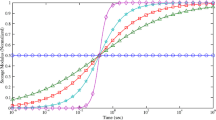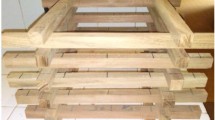Abstract
Fitting of experimental creep-recovery curves obtained from rheological tests carried out on viscoelastic materials can reveal difficulties when handled by classical rheological theories, which generally provide exponential-type functions requiring a great number of parameters to be determined. Fractional calculus may represent a natural framework to develop more synthetic and efficient methods, overcoming most of the problems encountered with the classical approach. In this paper, a fractional model consisting of a dashpot in series with a springpot is proposed to describe the viscoelastic behavior of modified bituminous binders used in road pavements. The purpose is twofold: (i) to evaluate the adequacy of a rheological model involving a limited number of parameters, each of which with a precise physical meaning; (ii) to improve the accuracy of other fractional approaches proposed in literature. The investigation was validated by means of experimental data gathered from shear creep-recovery tests carried out at various temperatures on two modified bituminous binders containing a styrene–butadiene–styrene polymer and crumb rubber from end-of-life tires.








Similar content being viewed by others
References
Atanackovic TM, Pilipovic S, Zorica D (2011) Distributed-order fractional wave equation on a finite domain. Stress relaxation in a rod. Int J Eng Sci 49:175–190
Atanackovic TM, Pilipovic S, Zorica D (2013) Forced oscillations of a body attached to a viscoelastic rod of fractional derivative type. Int J Eng Sci 64:54–65
Bai F, Yang X, Zeng G (2014) Creep and recovery behavior characterization of asphalt mixture in compression. Constr Build Mater 54:504–511
Barpi F, Valente S (2003) Creep and fracture in concrete: a fractional order rate approach. Eng Fract Mech 70:611–623
Barpi F, Valente S (2004) A fractional order rate approach for modeling concrete structures subjected to creep and fracture. Int J Solids Struct 41:2607–2621
Bradshaw RD, Brinson LC (1997) A sign control method for fitting and interconverting material functions for linearly viscoelastic. Solids Mech Time-Depend Mater 1:85–108
Caputo M, Mainardi F (1971) Linear models of dissipation in anelastic solids. Nuovo Cimento 1:161–198
Carpinteri A, Mainardi F (1997) Fractals and fractional calculus in continuum mechanics. Springer-Verlag, Wien
Celauro C, Fecarotti C, Pirrotta A, Collop A (2012) Experimental validation of a fractional model for creep/recovery testing of asphalt mixtures. Constr Build Mater 36:458–466
Collins JH, Bouldin MG, Gelles R, Berker A (1991) Improved performance of paving asphalts by polymer modification. J Assoc Asphalt Paving Technol 60:43–79
Di Mino G, Airey G, Di Paola M, Pinnola F, D’Angelo G, Lo Presti D. Linear and nonlinear fractional hereditary constitutive laws of asphalt mixtures. J Civil Eng Manage. doi:10.3846/13923730.2014.914104
Di Paola M, Pirrotta A, Valenza A (2011) Visco-elastic behavior through fractional calculus: an easier method for best fitting experimental results. Mech Mater 43:799–806
Di Paola M, Pinnola F, Zingales M (2013) A discrete mechanical model of fractional hereditary materials. Meccanica 48:1573–1586
Hilfer R (2000) Fractional calculus in physics. World Scientific Pub Co, Singapore
Hsu T, Chen S, Hung K (2011) Performance evaluation of asphalt rubber in porous asphalt-concrete mixtures. J Mater Civil Eng 23:342–349
King GN, Muncy HW, Proudhomme JB (1986) Polymer modification: binder’s effect on mix properties. J Assoc Asphalt Paving Technol 55:519–540
Lai J, Bakker A (1995) An integral constitutive equation for nonlinear plasto-viscoelastic behavior of high density polyethylene. Polym Eng Sci 35:1339–1347
Lee S-J, Akisetty CK, Amirkhanian SN (2008) The effect of crumb rubber modifier (CRM) on the performance properties of rubberized binders in HMA pavements. Constr Build Mater 22:1368–1376
Levenberg E (2009) Viscoplastic response and modeling of asphalt-aggregate mixes. Mater Struct 42:1139–1151
Lou YC, Schapery RA (1971) Viscoelastic characterization of a non-linear fiber-reinforced plastic. J Compos Mater 5:208–234
Machado JT, Kiryakova V, Mainardi F (2011) Recent history of fractional calculus. Commun Nonlinear Sci Numer Simul 11:1140–1153
Magin RL (2006) Fractional calculus in bioengineering. Begel House Inc, Redding
Mainardi F (1994) Fractional relaxation in anelastic solids. J Alloy Compd 211:534–538
Mainardi F (2010) Fractional calculus and waves in linear viscoelasticity: an introduction to mathematical models. Imperial College Press, London
Masad E, Huang CW, Airey G, Muliana A (2008) Nonlinear viscoelastic analysis of unaged and aged asphalt binders. Constr Build Mater 22:2170–2179
McDonald CH (1981) Recollections of early asphalt-rubber history. In: Proceedings of national seminar on asphalt-rubber, San Antonio
Meral FC, Royston TJ, Magin R (2009) Fractional calculus in viscoelasticity: an experimental study. Commun Nonlinear Sci Numer Simul 15:939–945
Merusi F, Giuliani F (2011) Intrinsic resistance to non-reversible deformation in modified asphalt binders and its relation with specific criteria. Constr Build Mater 25:3356–3366
Moreno F, Sol M, Martín J, Pérez M, Rubio MC (2013) The effect of crumb rubber modifier on the resistance of asphalt mixes to plastic deformation. Mater Des 47:274–280
Müller S, Kästner M, Brummund J, Ulbricht V (2013) On the numerical handling of fractional viscoelastic material models in a FE analysis. Comput Mech 51:999–1012
Nutting PG (1921) A new general law of deformation. J Frankl Inst 191:679–685
Nutting PG (1943) A general stress-strain formula. J Frankl Inst 253:513–524
Oeser M, Pellin T, Scarpas T, Kasbergen C (2008) Studies on creep and recovery of rheological bodies based upon conventional and fractional formulations and their application on asphalt mixture. Int J Pavement Eng 9:373–386
Park SW, Kim R, Schapery RA (1996) A viscoelastic continuum damage model and its application to uniaxial behavior of asphalt concrete. Mech Mater 24:241–255
Podlubny I (1999) Fractional differential equations. Academic Press, San Diego
Provenzano PP, Lakes RS, Corr DT, Vanderby R Jr (2002) Application of nonlinear viscoelastic models to describe ligament behaviour. Biomech Model Mechanobiol 1:45–57
Samko G, Kilbas AA, Marichev OI (1993) Fractional integrals and derivatives. Gordon and Breach, Amsterdam
Santagata E, Baglieri O, Dalmazzo D, Tsantilis L (2013) Evaluation of the anti-rutting potential of polymer modified binders by means of creep-recovery tests shear tests. Mater Struct 46:1673–1682
Santagata E, Baglieri O, Alam M, Dalmazzo D (2014) A novel procedure for the evaluation of anti-rutting potential of asphalt binders. Int J Pavement Eng. doi:10.1080/10298436.2014.942859
Schapery RA (1969) On the characterization of non-linear viscoelastic materials. Polym Eng Sci 9:295–310
Schapery RA (1997) Nonlinear viscoelastic and viscoplastic constitutive equations based on thermodynamics. Mech Time-Depend Mater 1:209–240
Schapery RA (1999) Nonlinear viscoelastic and viscoplastic constitutive equations with growing damage. Int J Fract 97:33–66
Schapery RA (2000) Nonlinear viscoelastic solids. Int J Solids Struct 37:359–366
Schiessel H, Metzler HR, Blumen A, Nonnenmacher TF (1995) Generalized viscoelastic models: their fractional equations with solutions. J Phys A: Math Theor 28:6567–6584
Sorvari J, Malinen M (2007) On the direct estimation of creep and relaxation functions. Mech Time-Depend Mater 11:143–157
Tschoegl NW (1989) The phenomenological theory of linear viscoelastic behavior: an introduction. Springer, Berlin
Uzan J (1996) Asphalt concrete characterization for pavement performance prediction. J Assoc Asphalt Paving Technol 65:573–607
Uzan J, Perl M, Sides A (1986) Numerical simulation of fatigue creep crack growth in a visco-elastoplastic material, II: experimental validation and application. Eng Fract Mech 23:333–344
Ye Y, Yang X, Chen C (2010) Modified Schapery’s model for asphalt sand. J Eng Mech 136:448–454
Author information
Authors and Affiliations
Corresponding author
Rights and permissions
About this article
Cite this article
Sapora, A., Cornetti, P., Carpinteri, A. et al. The use of fractional calculus to model the experimental creep-recovery behavior of modified bituminous binders. Mater Struct 49, 45–55 (2016). https://doi.org/10.1617/s11527-014-0473-6
Received:
Accepted:
Published:
Issue Date:
DOI: https://doi.org/10.1617/s11527-014-0473-6




